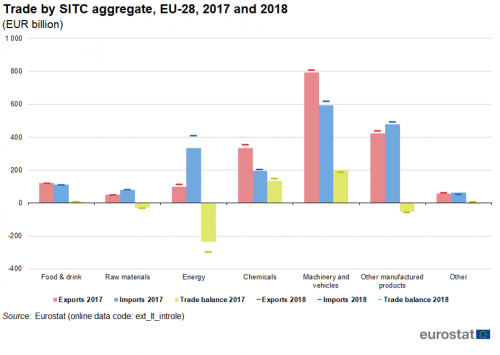Archive:EU and main world traders
Data extracted in November 2019
Planned update: November 2020
Highlights
The EU, the USA and China together accounted for 44% of exports and 46 % of imports of goods, globaly in 2018.
Machinery and vehicles were the most traded goods in 2018 for the EU, the USA and China .

(%)
Source: Eurostat (ext_lt_introle)
International trade — especially the size and evolution of imports and exports — is an important indicator of a country’s economic performance, showing its status on the international stage.
This article takes a closer look at recent trends in the imports and exports of goods by several of the world’s largest economies, focusing on key trade statistics for goods and giving an insight into EU trading patterns compared to the world’s major economies. The article only deals with extra-EU trade, and does not consider trade between EU Member States (intra-EU trade).
This article is part of the online publication International trade in goods - a statistical picture which provides recent statistics on international trade in goods, covering information on the EU's main partners, main products traded, specific characteristics of trade as well as background information.
Full article
Main world traders: EU, USA and China
In 2018, the EU-28, the United States and China recorded by far the world’s highest trade in goods values. Together, these countries accounted for around 44 % of global exports and 46 % of global imports of goods (see Figure 1).

(%)
Source: Eurostat (ext_lt_introle)
In 2018 China recorded the world’s highest export values at EUR 2 112 billion followed by the EU and the United States, which recorded values of EUR 1 956 billion and EUR 1 410 billion respectively (see Figure 2). Looking at imports by value, the United States had a higher value (EUR 2 211 billion) than the EU (EUR 1 979 billion) and China (EUR 1 808 billion). The United States also recorded the highest trade deficit (EUR 801 billion), followed by India (EUR 157 billion). Among the countries shown, Hong Kong (EUR 49 billion), the EU (EUR 23 billion), Mexico (EUR 12 billion), Japan and Canada (EUR 8 billion) also had trade deficits. The largest trade surpluses were recorded by China (EUR 304 billion) and Russia (EUR 179 billion). South Korea (EUR 59 billion) and Singapore (EUR 35 billion) also had a trade surplus.
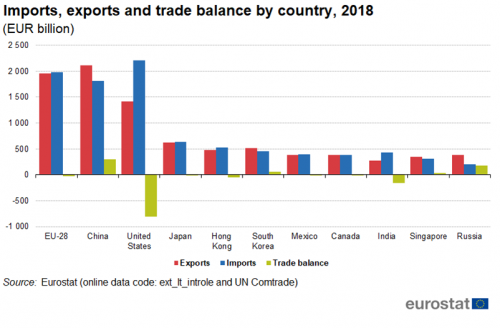
(EUR billion)
Source: Eurostat (ext_lt_introle)
The United States has traditionally been a major exporting economy but its significance was already smaller than that of the EU and China in 2008 (see Figure 3a). Between 2008 and 2018 the United States' share in total exports increased slightly from 10.9 % to 11.2 %. The steady growth of China’s exports saw it overtaking the EU in 2014, reaching a peak of 17.9 % in 2015; only in the last three years did the share drop to 16.8 %. The EU had a share of 16.2 % in 2008 which dropped to 15.1 % in 2012 and since 2013 has been close to 16 %. The national export shares of the other main traders are shown separately in Figure 3b to give some more detail.

(EUR billion)
Source: Eurostat (ext_lt_introle)
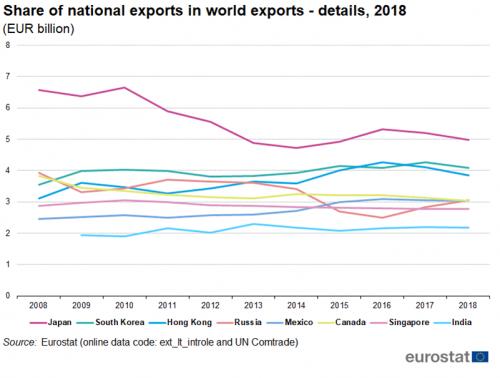
(EUR billion)
Source: Eurostat (ext_lt_introle)
China’s share in world imports has also increased, from 9.2 % in 2007 to 13.9 % in 2018 narrowing the gap with the EU and the United States (see Figure 4a). The United States remains the largest importer of goods, although its share fell from 17.5 % in 2008 to 17.0 % in 2018. The EU saw an even larger reduction from 18.9 % in 2008 to 15.2 % in 2018. The import shares of the other main traders are shown separately in Figure 4b to give some more detail.
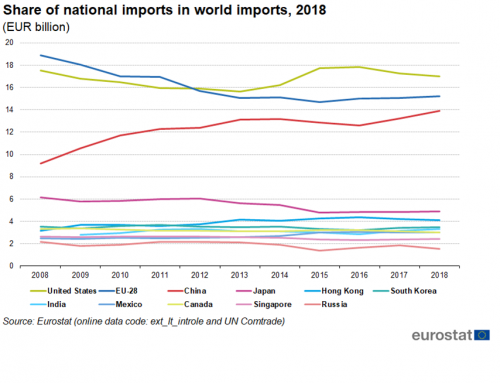
(EUR billion)
Source: Eurostat (ext_lt_introle)
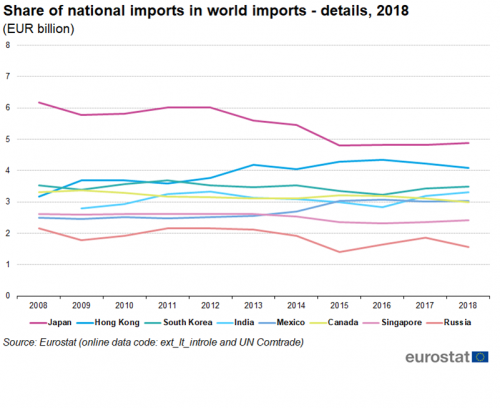
(EUR billion)
Source: Eurostat (ext_lt_introle)
EU-28 trade over time and by product group
Trade over time in the EU-28
In 2008 the EU had a trade in goods deficit of EUR 276 billion (see Figure 5). The average annual growth rate of EU exports was 5.8 % between 2008 and 2013. The corresponding growth of imports was 1.2 %. This resulted in a trade surplus of EUR 50 billion in 2013. However between 2013 and 2018 the growth rate for imports (3.3 %) was slightly higher than for exports (2.4 %) leading to a trade deficit of EUR 23 billion in 2018. Over the whole period the growth rate of EU trade in goods was 4.1 % for exports and 2.2 % for imports.
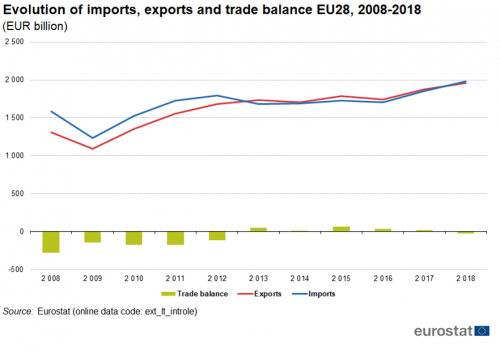
(EUR billion)
Source: Eurostat (ext_lt_introle)
Trade by SITC group in the EU-28
In 2018, machinery and vehicles was the EU’s most exported product group (EUR 809 billion) and made up 41 % of total exports (see Figure 6), while other manufactured products accounted for 22 % (EUR 439 billion) and chemicals for 18 % (EUR 356 billion). The combined share of manufactured goods made up 82 % of total EU exports in 2018.
Manufactured goods also made up the majority of EU imports (67 %) in 2017. The share of other manufactured products (25 %) was 3 % higher in imports than in exports. Import shares in machinery and vehicles(31 %) as well as chemicals (10 % ) were smaller than the corresponding export shares. The EU was the largest importer of energy (21 % worth EUR 412 billion) ahead of China (EUR 294 billion) and the United States (EUR 204 billion).
In 2018, the EU had a trade deficit in primary products (food & drink, raw materials and energy) and a trade surplus in manufactured products (chemicals, machinery and vehicles and other manufactured products). The deficit in primary products was largely due to the deficit in energy (EUR 298 billion) and to a lesser extent in raw materials (EUR 31 billion), while recording a small surplus in food and drink(EUR 9 billion). The surplus in manufactured goods came from machinery and vehicles (EUR 190 billion) and chemicals (EUR 152 billion) while there was a deficit in other manufactured products of EUR 55 billion.
United States trade over time and by product group
Trade over time in the United States
In 2008 the United States had a trade in goods deficit of EUR 588 billion (see Figure 7). The average annual growth rate of EU exports was 6.1 % between 2008 and 2013. The corresponding growth of imports was 3.5 %. But even this large difference only brought down the trade deficit by EUR 24 billion, resulting in a trade deficit of EUR 564 billion in 2013. Between 2013 and 2018 the growth rate for imports (4.8 %) was higher than for exports (3.5 %) leading to an increase in the trade deficit to a record level of EUR 801 billion in 2018. Over the whole period the growth rate of United States' trade in goods was 4.8 % for exports and 4.2 % for imports.
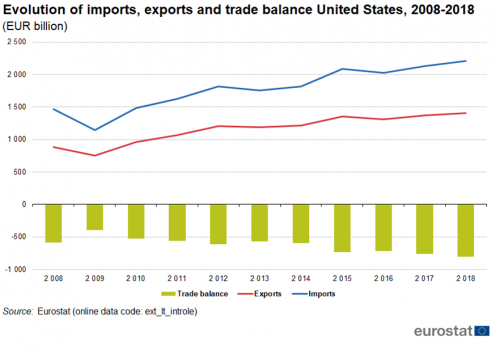
(EUR billion)
Source: Eurostat (ext_lt_introle)
Trade by SITC group in the United States
In the United States in 2018, machinery and vehicles(EUR 456 billion), other manufactured products (EUR 268 billion) and chemicals (EUR 189 billion) were the most exported products (Figure 8). Combined they accounted for almost two thirds of all exports. The same products were also the top three in imports, where combined machinery and vehicles (EUR 925 billion), other manufactured products (EUR 601 billion) and chemicals (EUR 223 billion) accounted for 80 % of all imports. With EUR 223 billion, the United States was the largest importer in the world of chemicals ahead of the EU (EUR 204 billion) and China (EUR 189 billion).
Just like the EU, in 2018 the United States had a trade deficit for energy (EUR 41 billion), however there were much larger deficits for machinery and vehicles(EUR 469 billion) and for other manufactured products (EUR 334 billion) as shown in Figure 7. The United States only had a trade surplus in raw materials (EUR 30 billion) and other goods (EUR 74 billion).
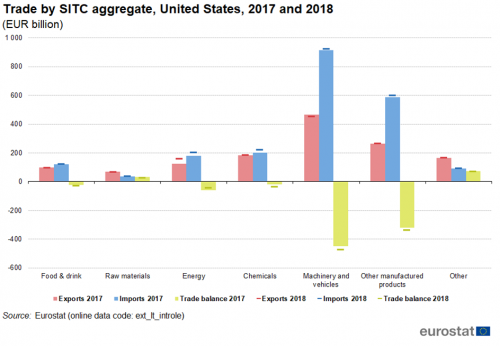
(EUR billion)
Source: Eurostat (ext_lt_introle)
China trade over time and by product group
Trade over time in China
In 2008 China had a trade in goods surplus of EUR 203 billion (see Figure 9). The average annual growth rate of its exports was 11.3 % between 2008 and 2013. The corresponding growth of imports was 13.8 %. This brought down the surplus to EUR 195 billion in 2013. Between 2013 and 2018 the growth rates of both exports and imports fell considerably. For imports (4.9 %) the growth rate was higher than for exports (4.2 %) leading to a a trade surplus of EUR 304 billion in 2018. Over the whole period the growth rate of Chinese trade in goods was 8.1 % for exports and 8.9 % for imports.
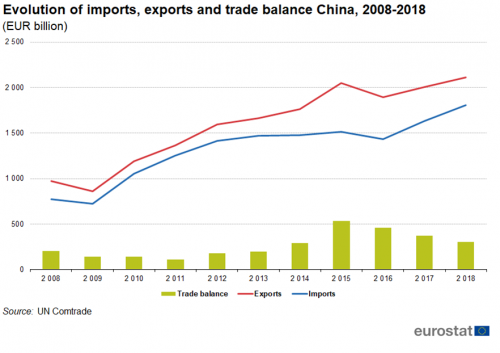
(EUR billion)
Source: Eurostat (ext_lt_introle)
Trade by SITC group in China
More than 94 % of China’s exports in 2018 were concentrated in manufactured goods. Machinery and vehicles (EUR 1024 billion, 48 %) was the largest group, followed by other manufactured products (EUR 827 billion, 39 %) and chemicals (EUR 142 billion, 7 %) as shown in Figure 10. China was the world’s leading exporter in machinery and vehicles and in other manufactured goods. In the latter its export value was higher than that of the EU and the United States combined.
China’s largest imports were also in machinery and vehicles(EUR 711 billion, 39 % of total imports) while the second largest imports were in energy (EUR 294 billion, 16 %). These were followed by other manufactured products (EUR 250 billion, 14 %), raw materials (EUR 237 billion, 13 %) and chemicals (EUR 189 billion, 10 %). Imports of other goods (EUR 64 billion, 4 %) and food and drink (EUR 61 billion, 3 %) were smaller. In 2018, China was the world’s leading importer of raw materials (EUR 237), importing more than twice as much as the EU (EUR 82 billion) and the United States (EUR 38 billion) combined.
China registered large trade surpluses in machinery and vehicles(EUR 323 billion) and especially in other manufactured products (EUR 576 billion). The largest trade deficits were recorded for raw materials (EUR 221 billion) and energy (EUR 255 billion).
Source data for tables and graphs
Data sources
EU data is taken from Eurostat's COMEXT database. COMEXT is the reference database for international trade in goods. It provides access not only to both recent and historical data from the EU Member States but also to statistics of a significant number of third countries. International trade aggregated and detailed statistics disseminated via the Eurostat website are compiled from COMEXT data according to a monthly process.
Data are collected by the competent national authorities of the Member States and compiled according to a harmonised methodology established by EU regulations before transmission to Eurostat. For extra-EU trade, the statistical information is mainly provided by the traders on the basis of customs declarations.
EU data are compiled according to community guidelines and may, therefore, differ from national data published by the Member States. Statistics on extra-EU trade are calculated as the sum of trade of each of the 28 EU Member States with countries outside the EU. In other words, the EU is considered as a single trading entity and trade flows are measured into and out of the area, but not within it.
Data for the other major traders are taken from the Comtrade database of the United Nations. Data availability differs among countries, therefore Figure 1 shows the latest common available year for all the main traders. For the calculation of shares in Figures 2 and 3 the world trade is defined as the sum of EU trade with non-EU countries (source: Eurostat) plus the international trade of non-EU countries (source: IMF Dots database).
Methodology According to the EU concept and definitions, extra-EU trade statistics (trade between EU Member States and non-EU countries) do not record exchanges involving goods in transit, placed in a customs warehouse or given temporary admission (for trade fairs, temporary exhibitions, tests, etc.). This is known as ‘special trade’. The partner is the country of final destination of the goods for exports and the country of origin for imports.
Product classification
Information on commodities exported and imported is presented according to the Standard international trade classification (SITC). A full description is available from Eurostat’s classification server RAMON.
Unit of measure
Trade values are expressed in billions (109) of euros. They correspond to the statistical value, i.e. to the amount which would be invoiced in case of sale or purchase at the national border of the reporting country. It is called a FOB value (free on board) for exports and a CIF value (cost, insurance, freight) for imports.
Context
Trade is an important indicator of Europe’s prosperity and place in the world. The block is deeply integrated into global markets both for the products it sources and the exports it sells. The EU trade policy is an important element of the external dimension of the ‘Europe 2020 strategy for smart, sustainable and inclusive growth’ and is one of the main pillars of the EU’s relations with the rest of the world.
Because the 28 EU Member States share a single market and a single external border, they also have a single trade policy. EU Member States speak and negotiate collectively, both in the World Trade Organization, where the rules of international trade are agreed and enforced, and with individual trading partners. This common policy enables them to speak with one voice in trade negotiations, maximising their impact in such negotiations. This is even more important in a globalised world in which economies tend to cluster together in regional groups.
The openness of the EU’s trade regime has meant that the EU is the biggest player on the global trading scene and remains a good region to do business with. Thanks to the ease of modern transport and communications, it is now easier to produce, buy and sell goods around the world which gives European companies of every size the potential to trade outside Europe.
Direct access to
- International trade in goods (t_ext_go), see:
- International trade in goods - long-term indicators (t_ext_go_lti)
- International trade in goods - short-term indicators (t_ext_go_sti)
- International trade in goods (ext_go), see:
- International trade in goods - aggregated data (ext_go_agg)
- International trade in goods - long-term indicators (ext_go_lti)
- International trade in goods - short-term indicators (ext_go_sti)
- International trade in goods - detailed data (detail)
- International trade in goods statistics - background
- International trade in goods (ESMS metadata file — ext_go_agg_esms)
- User guide on European statistics on international trade in goods
